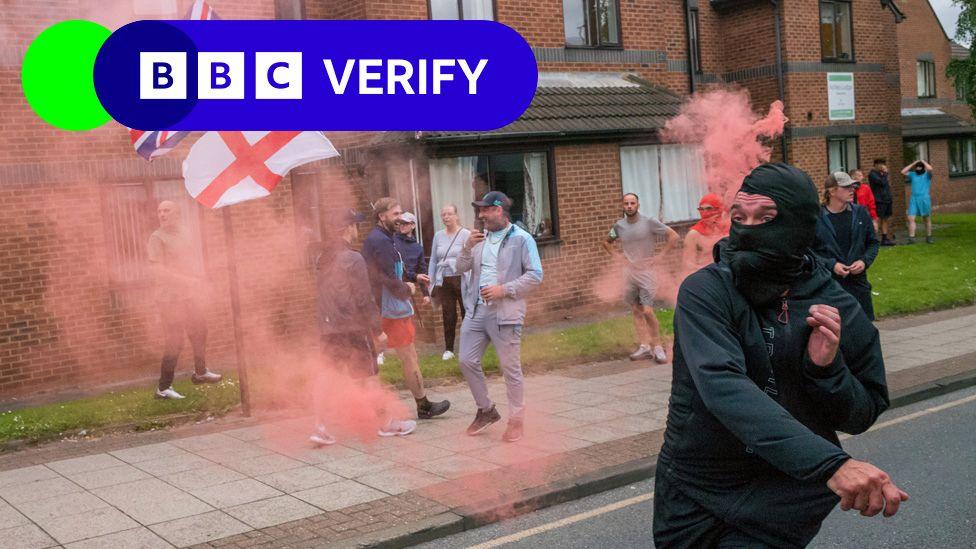'My colleague had heart attack as bricks hurled' - summer riots police speak out
Officers share their trauma policing the summer riots
- Published
"It's like being in a warzone – but you've just got a shield and stick," chief inspector Zoe Kelsey said.
She was one of the officers at the centre of the Middlesbrough riot which was sparked after three girls died in a knife attack in Southport earlier this year.
Her team faced barrages of bricks, protesters tried to set them on fire and one officer suffered a heart attack.
Ch Insp Kelsey has been a police officer for more than 25 years, but she said the riots across the UK over the summer tested her faith in humanity: "We're humans too, I'm a mam, a daughter, and a wife. They didn't care about that and just thought it'd be fun to cause harm to cops."
For the first time front-line officers have spoken openly about the violence they faced at the time and trauma it has left them with.
Several from Cleveland Police told the BBC they feared an officer could have been killed. It comes as police chiefs warned MPs that the impact of the riots on their budgets, officer welfare and caseloads will be felt for many more months to come, during a Parliamentary select committee this week.
On 4 August in Middlesbrough, in the sweltering heat of a summer's afternoon, people gathered for what was meant to be a peaceful protest and march after the fatal stabbing of Elsie Dot Stancombe, Alice da Silva Aguiar and Bebe King.
But it quickly turned into a rampage, fuelled by misinformation on social media that the suspect was an illegal migrant. Rioters across the UK exploited the tragedy to attack police, trash shops and set cars on fire.
About 1,000 people gathered in Middlesbrough, with only 125 officers on the ground.
A total of 916 people in England and Wales have appeared or are due to appear before the courts in connection with the national disorder, according to the latest government figures released on 2 December.
'People offered money to burn out police cars'
Ch Insp Kelsey was leading a team of riot trained officers, but they were outnumbered and under relentless pressure.
"I was screaming hold the line, hold the line," she said. "We just couldn't hold the line they were just pushing forward with such force."
As they walked towards the town centre groups splintered off turning into residential streets, smashing up homes, cars, and looting shops.
"You talk about the thin blue - well it was very thin that day, it really was. It was just mass disorder.
"They saw that we represented law and order, and that's what they were fighting."
Also there that day was PC Glen Teeley, who liaised with the protest organisers and was in the middle of the group as the march got under way.
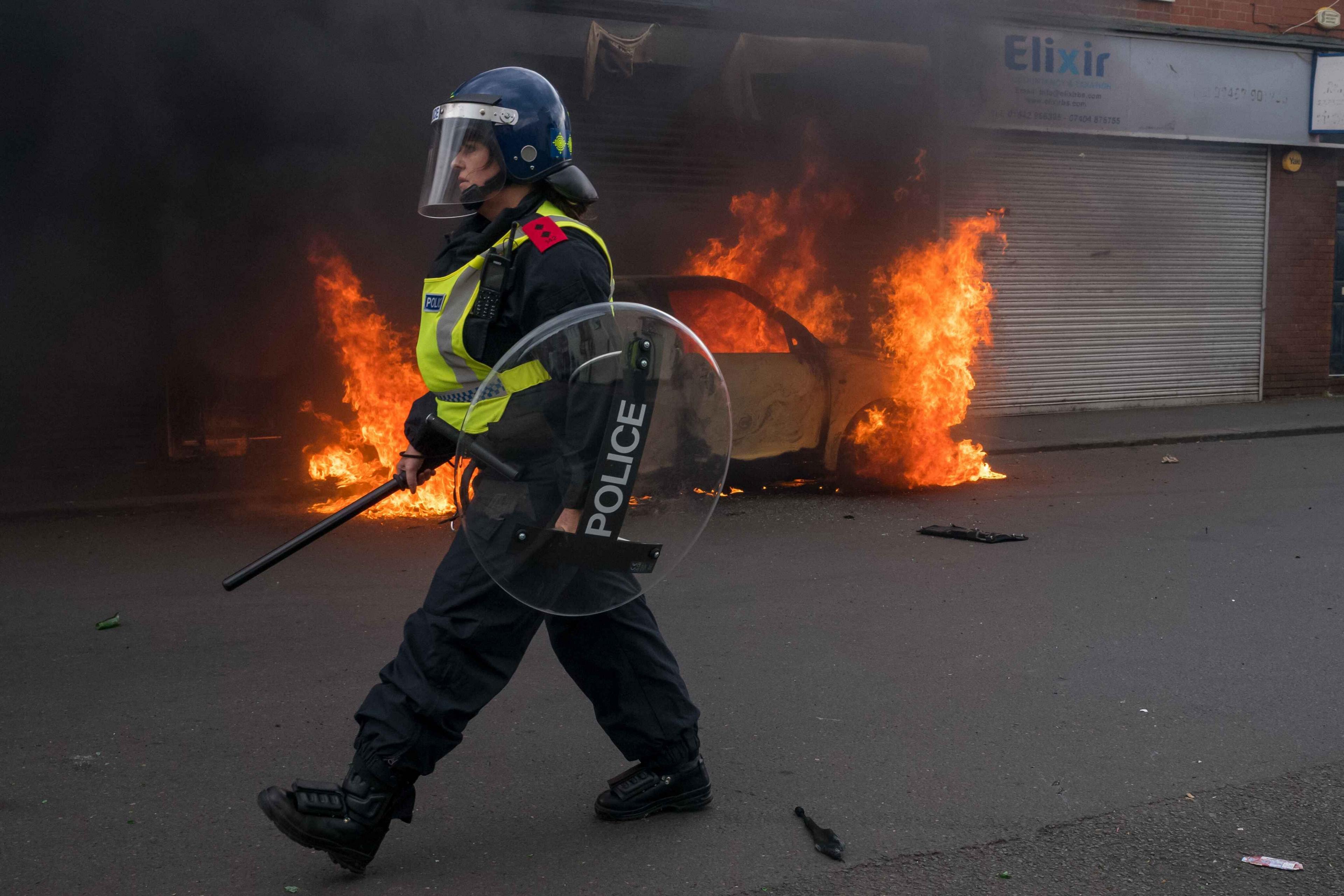
Ch Insp Kelsey, of Cleveland Police, in front of a burning car during the riots. She described the scene as "like a warzone"
He's spent more than a decade policing disorder at EDL marches and England football matches but said he'd never experienced anything like the Middlesbrough riot.
"There was people offering money to burn police cars out, rallying calls of we need to arm ourselves and if the police try to stop us, we're going to go over the top of them," PC Teeley said.
Hundreds of extra officers were rushed in from neighbouring forces boosting numbers on the ground. "It was just absolute carnage," Insp Adrian Dack said.
CCTV video showed shops being looted and YouTube footage captured rioters trying to set officers on fire with lit wheelie bins. Insp Dack said every time a wheelie bin was set on fire and thrown towards them, crowds cheered.
Ch Insp Kelsey told us watching rioters enjoy her colleagues being harmed troubled her greatly. "When someone got a brick here to their head, it was like 'Yay'. I don't think they stopped to think that we were humans behind that uniform".
'I thought he was going to die'
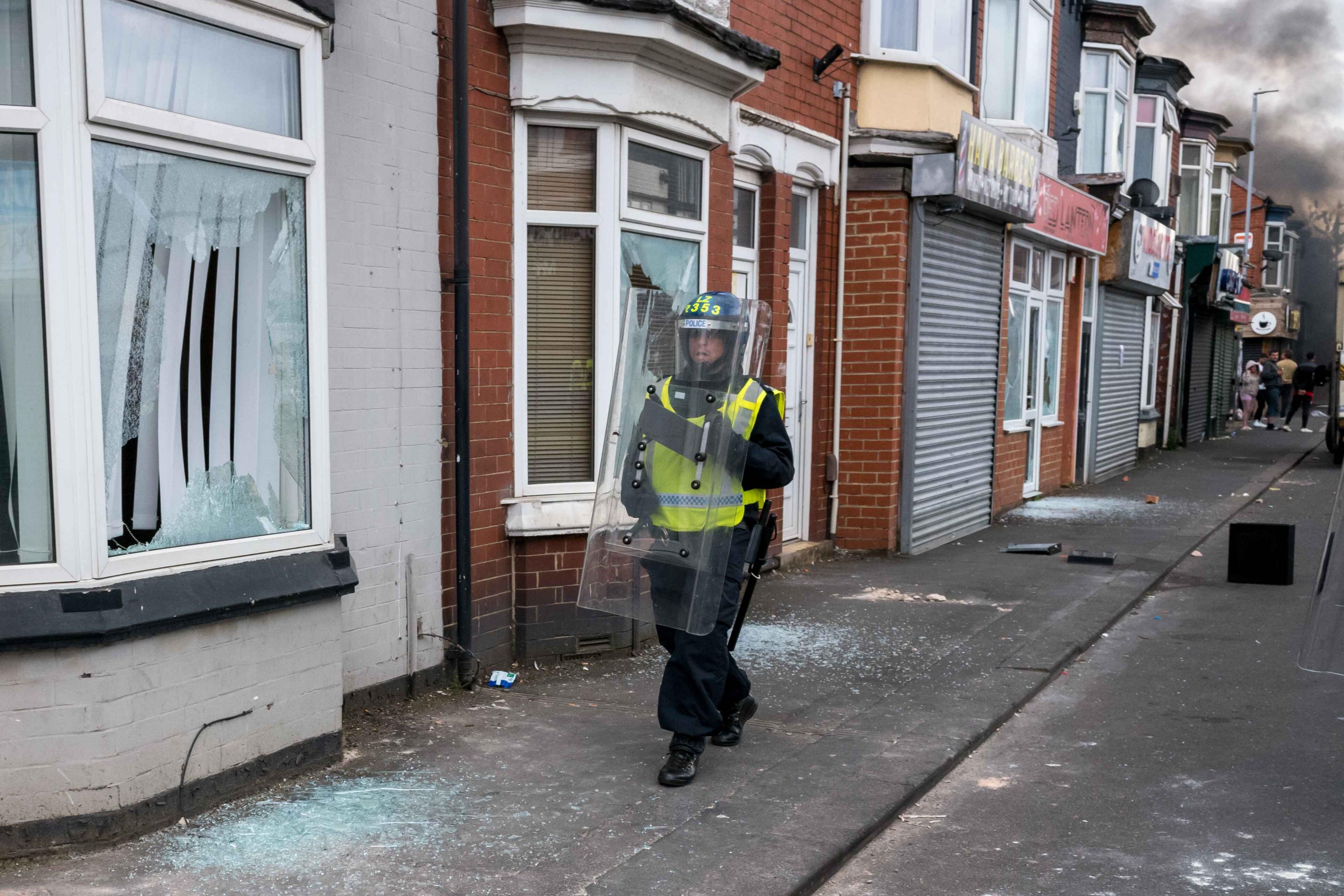
Rioters smashed the windows of homes, shops and takeaways during the disorder
After relentless clashes in the summer heat for more than two hours in full riot gear, with no breaks or food, one officer collapsed, the alarm went off immediately on police radios.
"We heard someone say something about a heart attack," said Ch Insp Kelsey, "a couple of minutes later, I heard the cop's name… And he was one of my cops on my van."
It was one of Insp Dack's best friends. He said: "He's on the floor, he's laying in his pants and socks and there's two officers there sort of working on him. And at that point my heart sinks."
Ch Insp Kelsey was one of the officers working on him, "I was just holding his hand and saying 'you're going to be alright, you're alright.' It was awful. I didn't think he was going to make it".
Paramedics had to navigate around the disorder to reach the officer, "but they came straight into the officer and started getting him right," said Insp Dack, "my mind had gone, I would say, for that short period of time".
Ch Insp Kelsey said as soon as her colleague was in the ambulance, she had to return to the line of disorder. "That night I went home I couldn't sleep at all. I didn't know if he was dead or alive."
Ch Insp Kelsey and Insp Dack's colleague was treated in hospital and continues his recovery.
'It was like some kind of spectator sport'
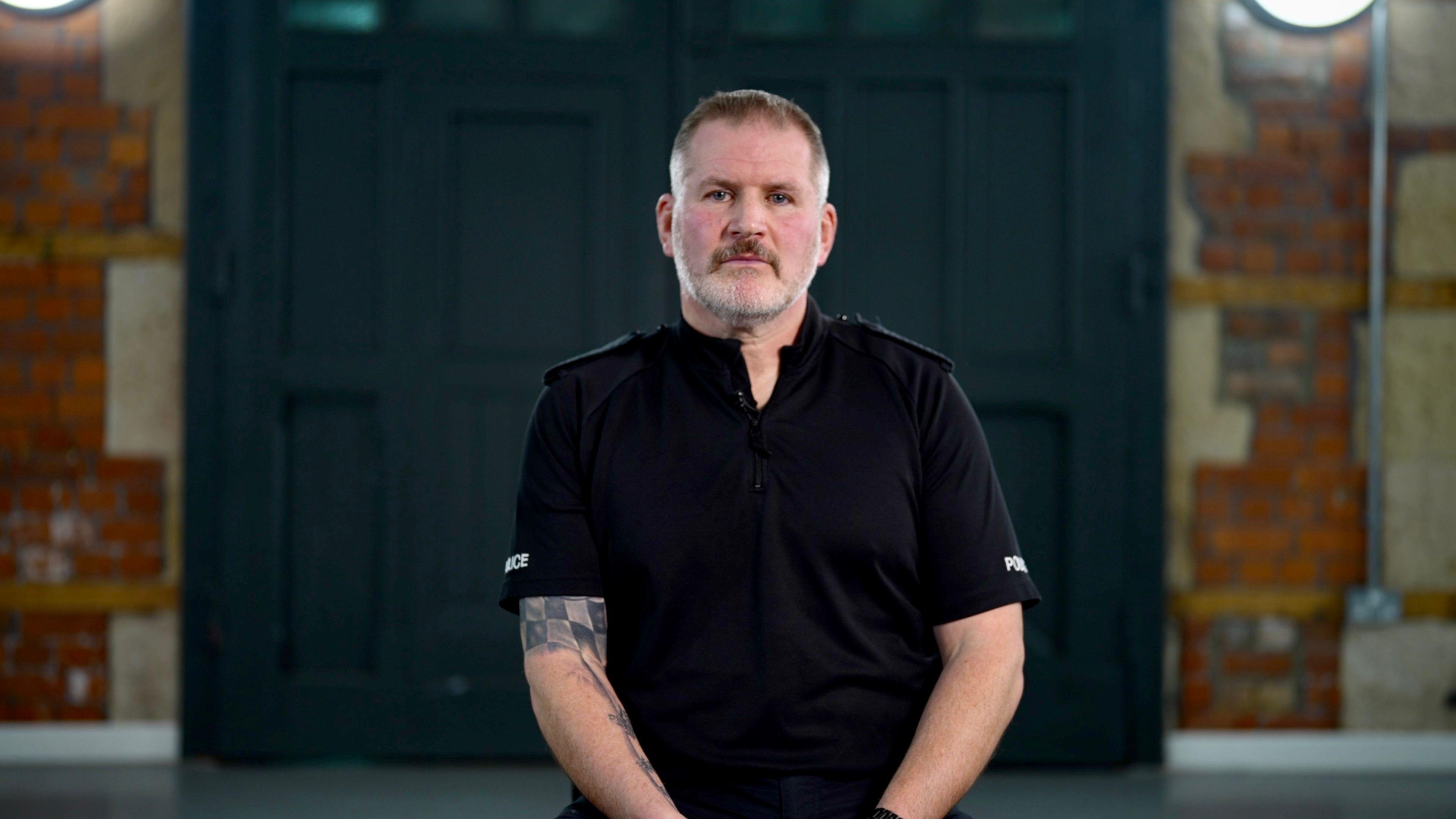
Constable Glen Teeley said the rioters "draw the life and soul out of the community"
Cleveland Police said like elsewhere in the country much of the disorder was live-streamed on social media.
"When I looked to my left, there were about 200 people just filming us," Ch Insp Kelsey said.
"Hundreds of people thought this was highly entertaining, like it was some kind of spectator sport. They just wanted to see the reaction on police officers' faces. It's like going back hundreds of years to like, ancient Rome."
Footage from a TikTok account showed a roadblock being set up on a busy junction while a man asked drivers if they were white before they could pass. The rioter has since been jailed for violent disorder.
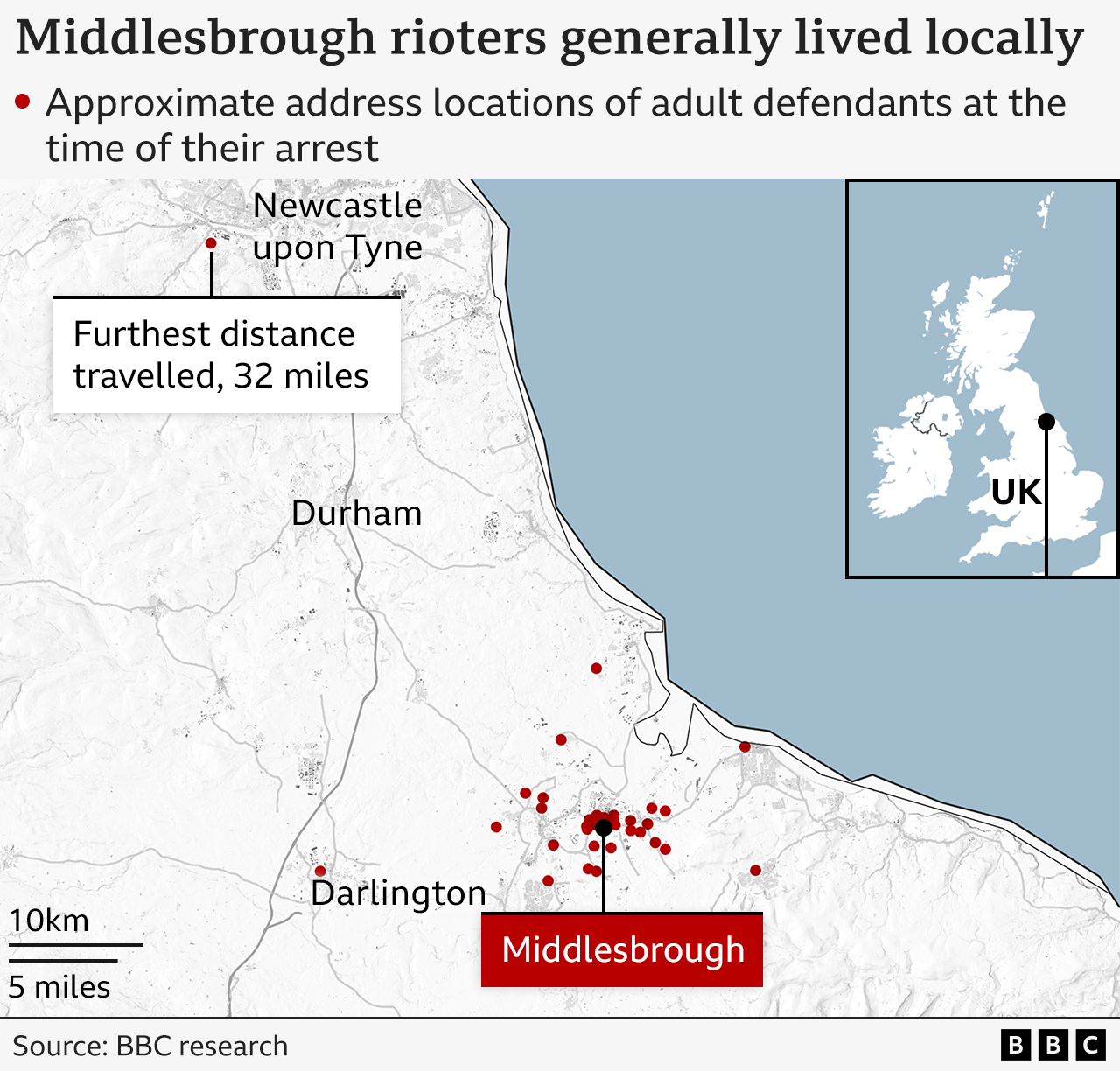
The force estimates that more than £750,000 worth of damage was caused.
"I think they were just on a rampage," said PC Teeley who described rioters as parasites. "These people have no place in society, the ones that were causing the carnage - are the people that draw everything out of the community, draw the life and soul out the community, give nothing but take everything".
Analysis of police and court records by BBC News shows that the Middlesbrough rioters were aged between 14 and 56, the average age of a rioter was 25.
The figures show that most of those who participated in the disorder in Teesside were local. Of the 44 adults prosecuted in Middlesbrough and captured in the BBC's analysis, 34 of them lived within three miles of the town and all but two lived within seven miles.
'I felt as though I could have broken down'
It's five months since disorder spread across the UK, but its impact is still being felt in policing today.
At the time the home secretary estimated 40,000 additional officer shifts were required, external by public order officers to police the riots.
This week several chief officers, including the chief constable of Cleveland Police warned MPs that the long-term financial and emotional impact for their forces and officers involved will affect caseloads and budgets for 18 months.
Some traumatised officers, they said, will be changed for the rest of their lives.
"I think it was really traumatic for everyone involved, really traumatic," Ch Insp Kelsey said. "I didn't sleep for months after, I couldn't sleep."

Insp Adrian Dack, who was born and bred in Hartlepool, was also on the frontline on 4 August
Insp Dack said when he finally did stop after the riots on a family holiday, he struggled.
"I just sort of hit the floor. I felt as if I could have just broken down, to be honest," he said.
The officers we spoke to said they cared deeply about the communities they police but feared riots could happen again.
Insp Dack has more than 20 years' experience in some of the town's most deprived communities.
He's also a dad and coaches a girls football team, "I think about the kids growing up. I want them to grow up somewhere safe".
But he is quick to add that if disorder does break out, he'll be back on the front line.
"Yes, I don't even need to think about that one" said Insp Dack, " If that comes again - am I ready? Are the officers ready? Yes".
Additional reporting by: Rob England, Phil Leake, Libby Rogers, Jonathan Fagg, Lauren Woodhead, Muskeen Liddar and Ellen Kirwin
- Published25 October 2024
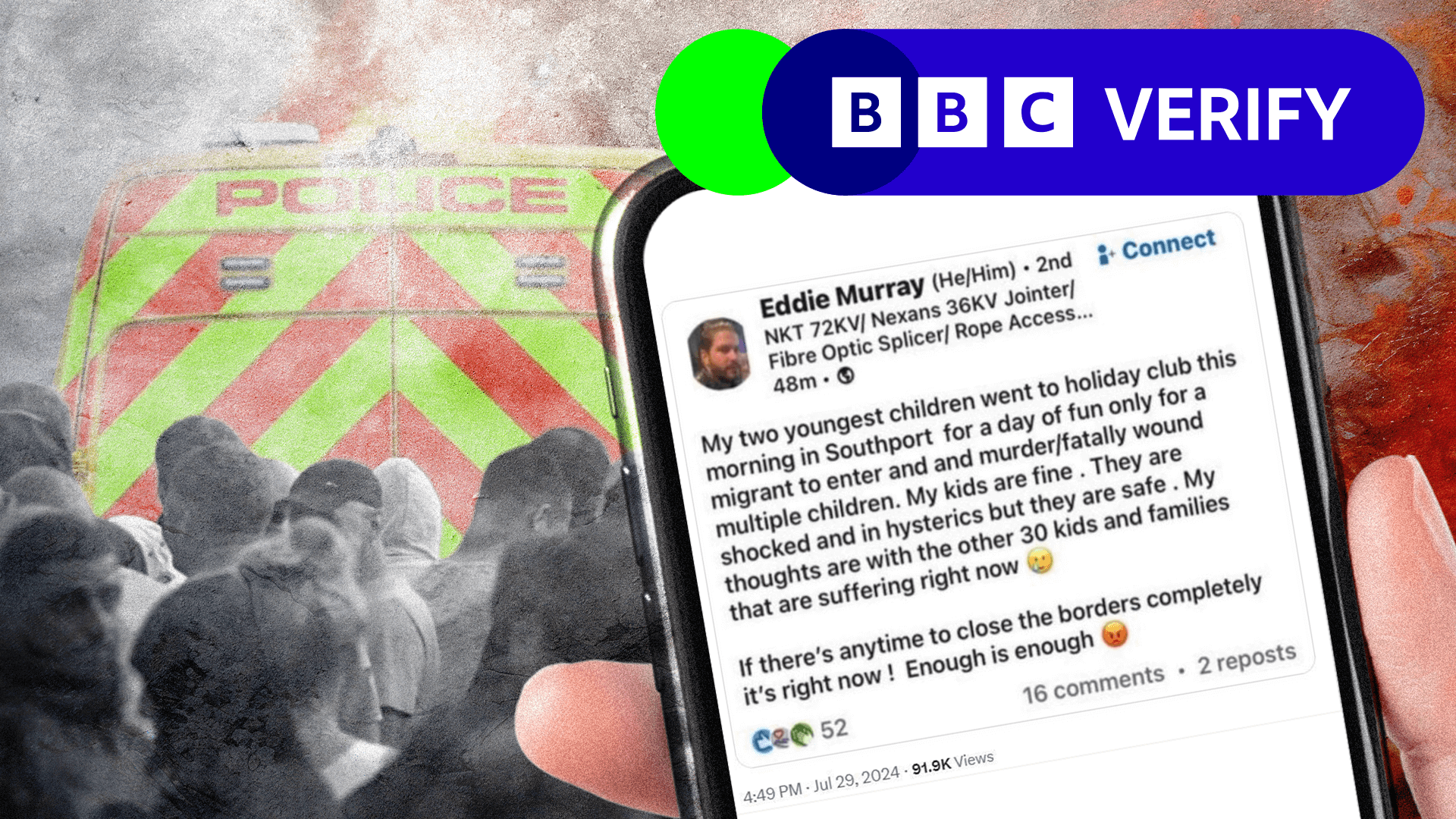
- Published2 October 2024
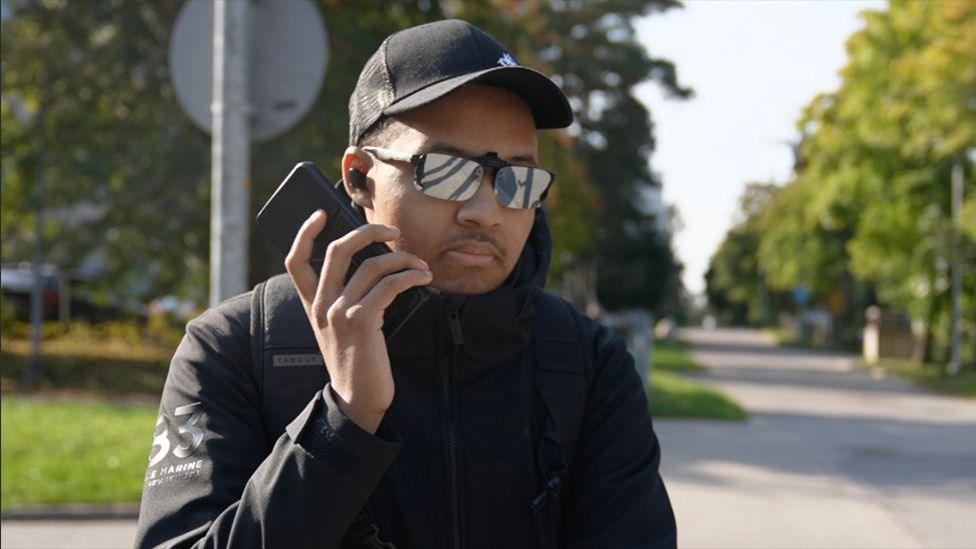
- Published8 August 2024
